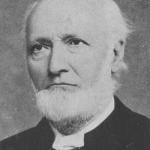
(Wikimedia Commons public domain image)
One of the hypotheses that have been offered to account for near-death experiences or NDEs suggests that they result from oxygen deficiency in the brain of the experiencer. An extremely severe and life-threatening oxygen deficit results in a brief spell of abnormal brain activity, which is followed first by reduced activity and, finally, by the loss of brain activity altogether. But this results in the blockage of certain receptors in the brain and, concomitantly, in the release of endorphins. Endorphins are a kind of morphine that is produced by the body itself, which cause hallucinations along with a sense of bliss and peace.
Pim van Lommel, a respected Dutch cardiologist who has become one of the leading authorities in the world on NDEs, does not find this persuasive. Here are some notes on the subject taken from Pim van Lommel, Consciousness Beyond Life: The Science of the Near-Death Experience (New York: HarperCollins, 2010), 114-116:
When cardiac arrest disrupts blood flow to the brain, or asphyxiation interrupts breathing, unconsciousness results. This is caused by anoxia, a total cessation of oxygen supply to the brain. In such cases, breathing stops. All physical and brain-stem reflexes stop. And, unless resuscitation commences again within five or ten minutes, the patient dies.
Hypoxia, however, is not the same things as anoxia. It is oxygen deficiency, not a total lack of oxygen. It can be seen with low blood pressure (shock), and with heart failure or “tightness” in the chest. In such cases, the result isn’t unconsciousness but, rather, confusion and agitation. Brain damage after awaking from a coma is also associated with confusion, fear, agitation, defects in memory, and muddled speech.
This theory seems inapplicable, however, because an NDE is actually accompanied by an enhanced and lucid consciousness with memories and because it can also be experienced under circumstances such as an imminent traffic accident or a depression, neither of which involves oxygen deficiency. Moreover, a hallucination is an observation that is not rooted in reality, which does not apply to descriptions of out-of-body experiences that are open to verification and corroboration by witnesses. In an out-of-body experience, patients during resuscitation have perceptions from a position outside and above their lifeless body, and doctors, nurses, and relatives can later verify the reported perceptions. They can also corroborate the precise moment the NDE with out-of-body experience occurred during the period of CPR. Besides, one would not expect hallucinations when the brain no longer functions because they require a functioning brain. . . . Additionally, it should also be mentioned that in an empathetic NDE, or “shared death experience,” the content of this experience is identical to a classic NDE, . . . while people who experience this “shared death experience” have obviously no physiological abnormalities like oxygen deficiency whatsoever. (115)
To be continued.












